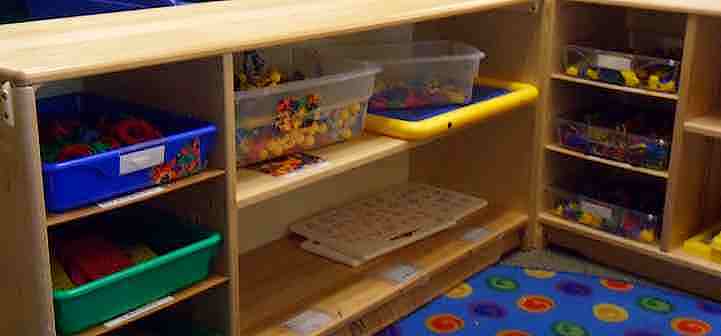
Manipulatives and table toys give children the opportunity to develop their fine motor skills while exploring different numbers, shapes, and colors. This center should have easily manageable materials for children.
Setting Up a Classroom Center for Manipulatives and Table Toys
- Location: This center should be in an area with table(s) and chairs, or a quiet floor area with a rug. Because working with manipulatives requires quiet concentration, it may be best to separate this area from noisy areas such as blocks and dramatic play. Low shelves can be used as a divider and a place to store materials.
- Display: Store materials in bins or containers on low shelves that give children easy access. It may be useful to rotate the materials so children have the chance to explore different colors, shapes, and sizes.
What a Manipulatives/Table Toys Center Should Look Like
- Well stocked with a variety of materials: Offer a variety of materials for children to use. Children can easily become bored with the same manipulatives and table toys, so you will want to change the materials regularly.
- Neat and organized: Children should be able to find the materials they want to help them explore numbers, shapes, sorting, and building without having to search through a lot of clutter. Also, if the center is organized, the expectation is that the children will help keep it that way.
- Limitless: An inviting and well-stocked manipulative/table toy center encourages children to practice their fine motor skills at the same time they are exploring patterns, shapes, and construction. Within reason, children should be allowed to follow their manipulative interests.
- Storage: Store materials in bins or containers on low shelves that give children easy access.
Choosing Materials
The following are some examples of materials that can be used in the manipulatives/table toys center. This is just a beginning list; feel free to rotate other materials in this center, depending on your curriculum and the children’s interests.
- puzzles (puzzle pieces, number puzzles, puzzle rack, etc.)
- blocks (bristle, Lego, nesting, stacking, building, etc.)
- games (lotto, color and shape, number, etc.)
- pegs and pegboards
- counters and sorting containers
- wheel and gear boards
- miscellaneous, child-directed items (beads, laces, pattern cards, snap-together materials, etc.)
Keep in mind that many of these suggestions would be appropriate for a group of preschool-age or school-age children.The manipulatives you choose for a toddler classroom may look different, because toddlers’ fine motor and cognitive skills are still developing. Be especially cautious about offering materials that are choking hazards to very young children, who may still be likely to place objects in their mouths. Supervise children of all ages when they are using manipulative materials.
For More Information
To learn more about toys and learning centers in child care, take a look at the following eXtension Alliance for Better Child Care articles:
- The Manipulatives/Table Toys Center in Child Care
- Using Learning Centers in Child Care
- Keys to Planning Successful Learning Centers in Child Care
- Toys and Materials in Child Care
- Finding Inexpensive Toys for a Child Care Program
Photo by Diane / CC BY http://creativecommons.org/licenses/by/2.0/
